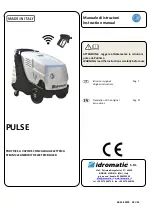
HAF-601 (13-0087) Air Station
SB-6-132-G
Replaces SB-6-132-F
IMPORTANT: Read and follow all INSTRUC-
TIONS and SAFETY PRECAUTIONS before
installing, operating or maintaining this
equipment. Keep this manual for future
reference.
SPECIFICATIONS
(1) Air Filter (Separator): 13-0041
Air Inlet Thread
1/2" NPT(F)
Air Outlet Thread
1/2" NPT(F)
Air Flow Capacity
100 CFM
Max. Temperature
150° F (65.6° C)
Max. Inlet Pressure
150 PSIG
Auto. Mechanical Drain
Supplied
Filter Element
5 Micron
(2) Coalescing Filter:
HAF-505
Air Inlet Thread
1/2" NPT(F)
Air Outlet Thread
1/2" NPT(F)
Air Flow Capacity
55 CFM
Max. Inlet pressure
150 PSIG
Max. Operating Pressure 150 PSIG
Max. Temperature
150° F (65.6° C)
Auto. Mechanical Drain
Standard
Filter Element
0.01 Micron
(3) Charcoal Filter:
HAF-517
Air Inlet Thread
1/2" NPT(F)
Air Outlet Thread
1/2" NPT(F)
Air Flow Capacity
75 CFM @
100 PSI
Max. Operating Pressure 150 PSIG
(10.3 Bar)
Max. Temperature
150° F (65.6° C)
Manual Mechanical Drain Standard
Pressure Differential
Indicator
Standard
Aerosol Filter
.003 ppm./wt.
Particulate Filter
3.0 micron
(4) Flow-Thru Regulator: HAR-508
Flow-Thru Ports
1/2" NPT(F)
Regulated Ports
1/4" NPT(F)
Air Flow Capacity,
28 CFM @
60 PSI
Regulated Ports
With 100 PSI
Inlet
Max. Temperature
175° F (79.4° C)
Max. Inlet Pressure
300 PSIG
Regulator Range
0-125 PSIG
(5) Tool Air Regulator:
HAR-507
Air Inlet Port
3/8" NPT(F)
Air Outlet Port
1/4" NPT(F)
(3 ea.)
Air Flow
60 CFM
Max. Temperature
120° F (65.6° C)
Max. Inlet Pressure
150 PSIG
Regulator Range
0 to 125 PSIG
DESCRIPTION -– AIR STATION
All components in Figure 1 are included
with the air station. This unit is designed
to provide a source of clean, filtered air for
the connection of both a DeVilbiss supplied
air respirator and a paint spray gun. The
unit removes dirt, pipe scale, water, oil,
Service Bulletin
Risk of explosion or fire. Improper use
can cause personal injury.
• This product is designed and
intended for use in industrial
compressed air systems only.
Do not use for liquids or gasses
other than air.
• Do not use where pressure or tem-
perature can exceed rated operating
conditions (see specifications).
• Regulated outlet pressure must
never be set higher than the
maximum operating pressure of the
downstream air tool or equipment.
An outlet pressure gauge should
always be used.
2
5
4
3
1
Figure 1
liquid aerosols, hydrocarbons and odors.
One regulated port is provided for the
connec tion of a DeVilbiss breathable air
supply hose. A separate regulated port is
fitted with a 1/4" NPS(M) hose connection
for spraying applications.
BREATHING AIR REqUIREMENTS
Supplied breathing air, as defined by
OSHA 29 CFR 1910.134i and NIOSH 42 CFR
84.141, MUST meet or exceed the following
requirements for Type 1-Grade D breathable
air, as defined in Compressed Gas Associa-
tion (CGA-G7-1-1997):
Oxygen = 19.5-23.5% (Typical
atmospheric levels)
Oil (condensed) = 5 mg/m (milligrams
per cubic meter) maximum
Carbon Monoxide (CO) = 10 ppm
(parts per million) max.
Carbon Dioxide (CO
2
) = 1000 ppm
(parts per million) max. (Typical
atmospheric levels)
Odor = The presence of a pronounced
odor should render the air as
unsatisfactory
It is up to the employer to assure that the
air compressor is properly maintained,
that the air compressor intake is located
in a clean contaminate free location
and that the air compressor is drawing
in typical atmospheric air, meeting all of
the national and local requirements for
breathing air.
This filter unit does not remove or filter Car-
bon Monoxide (CO). It is up to the employer
to ensure that the level of CO does not exceed
the maximum national or local allowed level.
The recommended method to assure that the
CO level is not exceeded is to install a carbon
monoxide monitor and alarm.
This filter unit will only remove particu-
late matter, water, oil and odor. This filter
unit will meet the particulate matter, oil
and odor requirements of Type 1-Grade D
Breathable Air and Compressed Breathing
Air, CSA-Z180.1 when:
• The filter unit is connected to a
compressed air source:
The compressor is properly
maintained
The air compressor intake is
located in a clean contaminate
free location
The air compressor is drawing
in typical atmospheric air,
meeting all of the national
and local requirements for
breathing air
• The filters are properly maintained
• A properly operating CO monitor
is installed


























